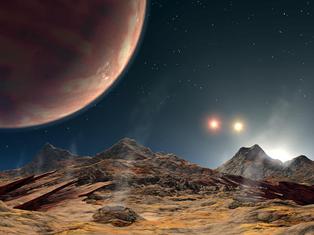A NASA funded astronomer has
now discovered a planet rotating around a member of a triple star system, thus
casting doubt upon old planetary theories of accretion disks condensing around
stellar objects, thus creating an opening
for new ideas. The idea of independent planetary masses coalescing, forming and
settling at a point of equilibrium between the forces of gravity and repulsion
between several cosmic objects should now explored in Planetary Formation
and Orbital Spacing as a viable explanation.
The Challenge: The same gravitational
tidal affects emanating from Jupiter, scientists have considered this theory to prevent planetary
formation in the asteroid belt. Should not these same set of parameters also apply here as two stellar
gravitational sources would disrupt and disperse any planetary formation from an
accretion disk of gas around the primary stellar object of the system. If you consider this discovery to be the exception, soon
many may find it to be the rule.
All Rights Reserved: ©Copyright
2005
Original
Page for Printing
Planet with three suns challenges
astronomers
 |
A NASA-funded astronomer has discovered a world where
the sun sets over the horizon, followed by a second sun and then a
third, as pictured in this artist's conception released by NASA July 13,
2005. The new planet, called HD 188753 Ab, is the first known to reside
in a classic triple-star system. The astronomer, Dr. Maciej Konacki of
the California Institute of Technology, Pasadena, California, found the
planet using the Keck I telescope atop Mauna Kea mountain in Hawaii. The
finding, reported in this week's issue of Nature, suggests that planets
are more robust than previously believed.
|
The planet, a gas giant slightly larger than
Jupiter, orbits the main star of a triple-star system known as HD 188753 in the
constellation Cygnus ("The Swan").
The stellar trio and its planet are about 149
light-years from Earth and about as close to each other as our sun is to Saturn,
U.S. scientists reported on Thursday in the current edition of the journal
Nature.
A light-year is about 6 trillion miles, the
distance light travels in a year.
If
you stood on the planet's surface, you would see three suns in sky,
although its orbit centers around the main yellow star among the trio.
The larger of the other two suns would be orange and the smaller would
be red, astronomers at California Institute of Technology said in a
statement.
An artists' rendering of the planet and
three stars, as seen from a hypothetical moon, is available at http:/pr.caltech.edu/media/trinary-sunset-small-1.jpg.
The new finding could upset existing
theories that planets usually form out of gas and dust circling a single
star, and could lead scientists to look in new places for planets.
"The implication is that there are
more planets out there than we thought," the commentary said.
Caltech astronomer Maciej Konacki, who
wrote the research article, refers to the new type of planets as "Tatooine
planets," because of the similarity to Luke Skywalker's view of his
home planet by the same name, with its multiple suns, in the original
"Star Wars" film.
The fact that a planet can even exist in a
multiple-star system is amazing in itself, according to Konacki. Binary
and multiple stars are quite common in the solar neighborhood, and in
fact outnumber single stars by some 20 percent.
But so far, most extrasolar planets --
those discovered outside our planetary system -- have been detected by
watching for a characteristic wobble in the stars their orbit,
reflecting the gravitation pull the planets exert on their suns.
This method is less effective for binary
and multiple star systems, and existing theories said planets were
unlikely to form in this kind of environment.
Konacki found a new way to identify
planets by measuring velocities of all bodies in a binary or multiple
star system.
07/14/05 13:26
Story
is a Courtesy of Reuters
|
|
©
Copyright Reuters Ltd. All rights reserved
|
Return
